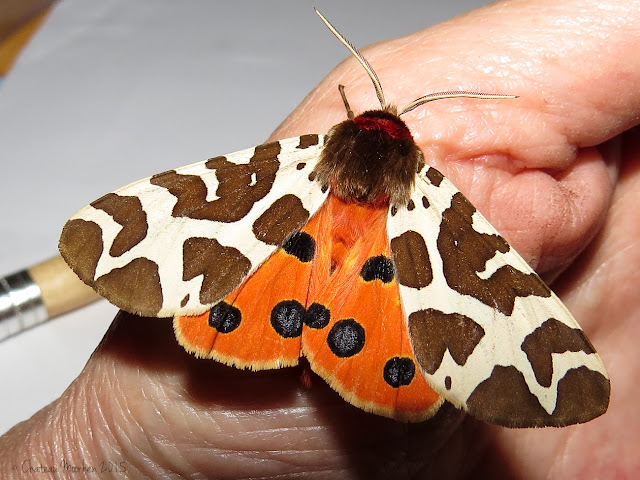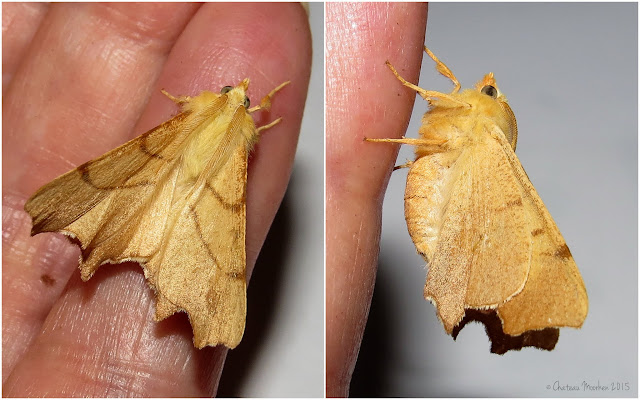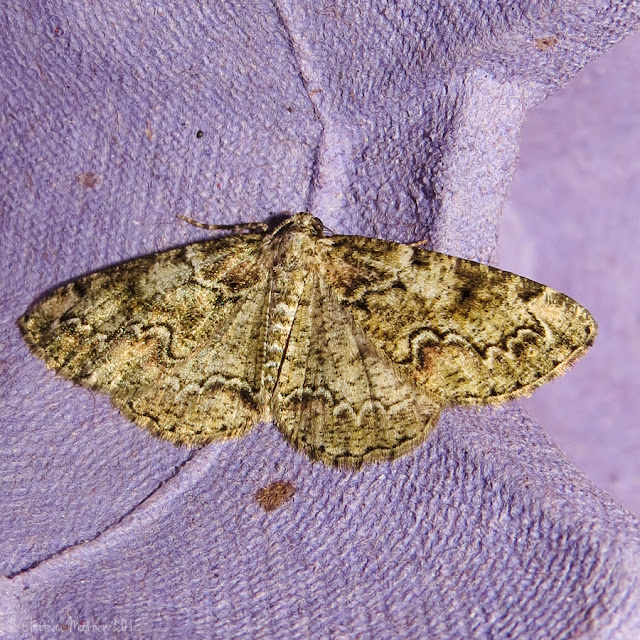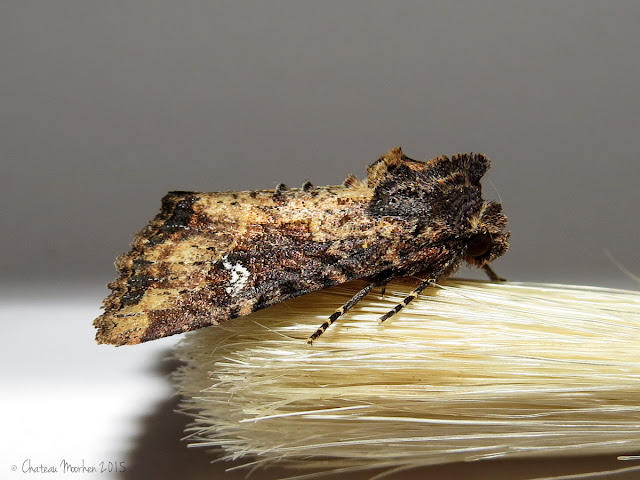These are all from the night of 18/19 August which was a fine clear night, and I was surprised by the variety of interesting moths. I haven't seen any hawkmoths since the very first time, but I don't want to find everything all at once anyway.
I'll start with this Tiger moth - I've seen one once before in my veg patch during the day and we had quite a photo session, but it was a surprise to find five of them in the trap that morning. They are stunning, especially when they deign to open up their wings like this.
 |
| Garden Tiger (Arctia caja). |
I said I was doing well with the family Lasiocampidae - well I had two more species this time! The Drinker below refused to stand still and would have flown off so I had to snap it quickly.
 |
| The Drinker (Euthrix potatoria). |
 |
| The Drinker (Euthrix potatoria), about ready to fly off. |
This Pine-tree Lappet was the same; it was happily asleep until I had to disturb it for a few photos then it was ready to fly off at any moment, even though it looks like it is asleep here.
 |
| Pine-tree Lappet (Dendrolimus pini). |
I knew I'd seen the markings of this next one before, but I still had to trawl through loads of photos before I found it!
 |
| Figure of Eighty (Tethea ocularis). |
I love this next one, the Lobster, but I'd rather see the caterpillar which is amazing, freaky, looks nothing like a caterpillar and looks rather like a ..... lobster! My white paper is looking a bit grubby here, well the moth had already had a trip up to the ceiling and been brought back for some photos, and sometimes you have to work fast with the flitty ones and there's no time to clean and tidy as you go. Although it did seem to fall asleep after its brief break for freedom.
I am rarely putting them in specimen jars any more except for when collecting them from the walls and ceilings, and then if they are flitty I cover them in a towel and that quietens them down, rather than putting them in the fridge. How I'm dealing with them now is transferring from the moth trap to a big plastic box with egg boxes in it and covering with a towel which seems to keep them mostly happy and quiet. (Thanks for the tip, Countryside Tales). Then as I go through them inside I transfer the ones I've looked at to another big plastic storage box with another towel over it. I still lose some when I am getting them out of the moth trap, and a number head off to the ceiling indoors when I go through the plastic box - otherwise I'd go through the moths outside in natural light. But I don't want to risk a really special one flying away outside.
 |
| Lobster moth (Stauropus fagi). |
 |
| Lobster moth (Stauropus fagi). |
I can't tell the difference between August and September Thorn moths, so the following is one or the other. I think.
 |
| Not sure but one of the Thorn moths (Ennomos sp). |
 |
| Pretty sure this is the Poplar Kitten (Furcula bifida) - they are adorable and very furry and sleepy. |
 |
| One of the Wainscots but I can't tell which one. |
If only more moths would open up their wings like the one below so you can see their underwings, it would make IDing for many of them so much easier. However I didn't need the underwings for this one!
 |
| Pebble Prominent (Notodonta ziczac). |
 |
| Pebble Prominent (Notodonta ziczac). |
Now for some Noctuid moths and I take back that they are all brown/grey and drab; many most certainly aren't!
 |
| Setaceous Hebrew Character (Xestia c-nigrum). |
 |
| A hint of green colour helps with ID. This is a Coronet (Craniophora ligustri). |
 |
| Rosy Rustic (Hydraecia micacea). |
As for the next one, well I spent ages trawling through photos only to discover it had been posted on several blogs just recently. In fact I was looking at a new (to me) blog, Caroline Gill's Wild and Wonderful and I thought - aha - that's that moth! Only to see in the caption a thank you to Ragged Robin for helping with ID - and yes, RR has posted one just recently too on her wildlife blog A Year In The Life Of My Wildlife Garden. I am now looking back on my mothy friends' moth posts over the last month or so as it's proving helpful!
 |
| Straw Underwing (Thalpophila matura). |
The ID for the next one came from RR too - only somewhere I found a blog giving brilliant info on how to tell the difference between Copper Underwing and Svensson's Copper Underwing. I've lost the link already but UK Moths says the same thing "Svensson's has dark palps with pale tips, whereas Copper Underwing's palps are pale throughout." So I deduce having seen the photos of the difference on the lost link that this one is Svensson's, which is why I included the photo of it running up my wrist, as you can just see the pale tip.
 |
| Svensson's Copper Underwing (Amphipyra berbera). |
 |
| Broad-barred White (Hecatera bicolorata). |
And to finish, a couple of Geometrids. This first one's larvae feeds on lichen, which was something that amazed me when I learned there were moths whose babies did this! I'm going to have to go out with a magnifying glass and start inspecting my lichen laden trees.
 |
| Brussels Lace (Cleorodes lichenaria). |
I haven't been bothering with the tiny ones as being new to moth trapping it's all a bit overwhelming, but this one was too stunning to not take a photo of!
 |
| Lime-speck Pug (Eupithecia centaureata). |
As usual, please tell me if there are any errors!
I shouldn't really be surprised that the larvae of many of the moths I've been catching feed on trees such as sallow (willow), poplar and oak, and also grasses. I have a heavily wooded garden as well as there being loads of trees all around the area, not to mention there is grass everywhere too, and it doesn't all go brown like my lawn on a slope. My orchard which is at the bottom of the hill beside the stream stays green in all but the worst of droughts, and there's plenty of wild grass and long vegetation on the banks of the barely trickling stream and even on the damp leaky side of my pond. The most important thing about this habitat is that it's not being chopped back at the wrong time of year by the council being tidy.
It's very interesting to learn more about the needs of these unknown to me before moths - we care about habitat and providing for the creatures that we see, but not so much the ones we normally don't, due to sheer ignorance! OK when I say we, I mean me..... :-)
* Benefits of Chemotherapy
1. It has knocked my menopausal hot flushes on the head! I was going crazy and seriously considering hormone replacement therapy, but although I get the chemo sweats sometimes, it's nothing like the horrible hot flushes. I hope they don't come back, but even if they do, at least it's one less horrid thing I've had to deal with during this time.
2. For about 20 years I've had an ugly but painless skin condition on one of my elbows called Granuloma Annulaire. I learned to live with it years ago after having various chunks of it chopped out by a dematologist in Geneva** - apparently way back then one of the treatments which sometimes worked (there is no real cure) was found whilst taking biopsies - cutting out a tiny bit of the skin could make it go away, or like for me, it changed the shape, broke up the ugly circles and for several years looked less severe. Some years it looks worse than others, often it nearly disappears in winter, just when you don't care as you are wearing long sleeves anyway, only for it to reappear in full force in the spring. It often appears on both elbows, or both knees or ankles etc so I considered myself lucky. Imagine my horror last year seeing it start to appear on my other elbow!
Well guess what. It's gone! I have rough skin on both elbows that may be due to the skin condition or more than likely the amount of time I have spent over the last six months lying down leaning on them.
It may come back, but it was pretty surprising when I noticed it had gone! :-)
** I used to live on the French border by Geneva - I didn't fly there for treatment from England or France! :-)




































